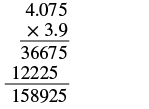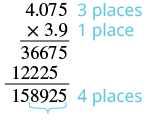| << Chapter < Page | Chapter >> Page > |
Multiplying decimals is very much like multiplying whole numbers—we just have to determine where to place the decimal point . The procedure for multiplying decimals will make sense if we first review multiplying fractions.
Do you remember how to multiply fractions? To multiply fractions, you multiply the numerators and then multiply the denominators.
So let’s see what we would get as the product of decimal s by converting them to fractions first. We will do two examples side-by-side in [link] . Look for a pattern.
| A | B | |
|---|---|---|
| Convert to fractions. | ||
| Multiply. | ||
| Convert back to decimals. |
There is a pattern that we can use. In A, we multiplied two numbers that each had one decimal place, and the product had two decimal places. In B, we multiplied a number with one decimal place by a number with two decimal places, and the product had three decimal places.
How many decimal places would you expect for the product of If you said “five”, you recognized the pattern. When we multiply two numbers with decimals, we count all the decimal places in the factors—in this case two plus three—to get the number of decimal places in the product—in this case five.

Once we know how to determine the number of digits after the decimal point , we can multiply decimal numbers without converting them to fractions first. The number of decimal places in the product is the sum of the number of decimal places in the factors.
The rules for multiplying positive and negative numbers apply to decimal s, too, of course.
When you multiply signed decimals, first determine the sign of the product and then multiply as if the numbers were both positive. Finally, write the product with the appropriate sign.
Multiply:
| Determine the sign of the product. The signs are the same. | The product will be positive. |
| Write the numbers in vertical format, lining up the numbers on the right. |
 |
| Multiply the numbers as if they were whole numbers, temporarily ignoring the decimal points. |
 |
| Place the decimal point. Add the number of decimal places in the factors Place the decimal point 4 places from the right. |
 |
| The product is positive. |
Multiply:
| The signs are different. | The product will be negative. |
| Write in vertical format, lining up the numbers on the right. | |
| Multiply. | |
 |
|
| The product is negative. |

Notification Switch
Would you like to follow the 'Prealgebra' conversation and receive update notifications?